-
Paper Information
- Next Paper
- Previous Paper
- Paper Submission
-
Journal Information
- About This Journal
- Editorial Board
- Current Issue
- Archive
- Author Guidelines
- Contact Us
International Journal of Agriculture and Forestry
p-ISSN: 2165-882X e-ISSN: 2165-8846
2014; 4(2): 100-105
doi:10.5923/j.ijaf.20140402.09
Physiological Traits of Wheat as Affected by Nitrogen Fertilization and Pattern of Planting
M. S. Alam
Department of Agronomy and Agricultural Extension, Faculty of Agriculture, University of Rajshahi, Rajshahi-6205, Bangladesh
Correspondence to: M. S. Alam, Department of Agronomy and Agricultural Extension, Faculty of Agriculture, University of Rajshahi, Rajshahi-6205, Bangladesh.
| Email: |  |
Copyright © 2014 Scientific & Academic Publishing. All Rights Reserved.
The experiment was conducted to physiological traits of wheat as affected by nitrogen fertilization and pattern of planting. The experiment consisted of two methods of planting viz. conventional and bed planting, four wheat varieties namely Protiva, Sourav, Shatabdi and Prodip and four levels of nitrogen viz. 0, 60, 110 and 160 kg N ha-1. Physiological traits increased at early stages and decreased at later stages of plant growth. The maximum leaf area ratio, specific leaf area and leaf weight ration were noticed in prodip. Protiva produced the highest net assimilation rate at crown root initiation to tillering stage. Net assimilation rate differed significantly due to nitrogen level. The highest net assimilation rate, leaf area ratio, specific leaf area and leaf weight ratio was recorded from 160 kg N ha-1 and the lowest one from the control treatment. Significantly the higher value for physiological traits was noticed in bed planting system compared to conventional one.
Keywords: NAR, LAR, SLA, LWR, Planting method, Nitrogen, Wheat
Cite this paper: M. S. Alam, Physiological Traits of Wheat as Affected by Nitrogen Fertilization and Pattern of Planting, International Journal of Agriculture and Forestry, Vol. 4 No. 2, 2014, pp. 100-105. doi: 10.5923/j.ijaf.20140402.09.
1. Introduction
- Wheat is one of the most important food grain crop grown in the world. It ranks first in the world cereal crops accounting for 30% of all cereal food worldwide and is a staple food for over 10 billion people in as many as 43 countries of the world. It provides about 20% of the total food calories for the human race [10]. In Bangladesh, wheat is one of the most important food grain crop. In Bangladesh among total food grain production in the 2010-11 was 34.5 mmt. in which the contribute of wheat was 0.97 mmt respectively [3] and in 2011-12 production of wheat 2.780 mt ha-1 [2]. Nitrogen occupies a conspicuous place in plant metabolism. All vital processes in plant are associated with protein, of which nitrogen is an essential constituent. Consequently to get more crop production, nitrogen application is essential in the form of chemical fertilizer. Nitrogen fertilizer is known to affect the number of tillers m-2, number of spikelet’s spike-1, number of Grains spike-1, spike length and 1000- grain weight [1]. Bed planting systems have been used in cultivation for centuries. The origin of raised bed cultivation has traditionally been associated with water management issues either by providing opportunities to reduce the impact of excess water in rainfed conditions or to more efficiently deliver irrigation water in high production irrigated systems [11]. Nitrogen use efficiency could be improved by 10% or more in furrow irrigated bed-planting systems because of improved N placement possibilities [4]. Also, the microclimate within the field was changed to the orientation of the wheat plants in rows on the beds, which reduced crop lodging and decreased the incidence of some wheat diseases. This was explained by the reduction in canopy humidity that is conducive to reduced disease pressure and enhanced healthy wheat growth. Variety also plays a vital role in increasing yield as recent developing variety has inherent capability to improve their product. In considering the above factors the present experiment was undertaken to study the physiological traits of wheat as affected by nitrogen fertilization and pattern of planting.
2. Materials and Methods
- The research work was carried out at Agronomy Field Laboratory, Department of Agronomy and Agricultural Extension, University of Rajshahi during the winter season. The experiment consisted of two methods of sowing viz. conventional planting (S1) bed planting (S2) and four wheat varieties namely Protiva (V1), Sourav (S2), Shatabdi (S3) and Prodip (V4) and four levels of nitrogen viz. 0 (N0), 60 (N1), 110 (N2) and 160 (N3) kg N ha-1. The experiment was laid out in a split-split plot design with three replication. The plot size was 3m x 4m. Triple super phosphate (TSP), muriate of potash (MoP) and gypsum were applied to the plots at the rate of 180, 50, 120 kg ha-1 during final land preparation. Nitrogenous fertilizer was applied as per treatment in two installments; two-third at the time of final land preparation and one-third at 27 days after sowing . Seeds were sown in 25 cm apart rows opened by specially made an iron hand tine. Intercultural operation was done as and when necessary. Plant samples were collected from each plot using six rows for collecting data on growth parameters. Five plants per plot were carefully uprooted randomly at each growth stage. Leaf, stem and spike (when appeared) were separated from each plant sample. The samples were packed separately in labelled brown paper bags. Then the samples were oven dried for 72 hours at 70-80℃ and weights were taken separately with an electrical balance. Leaf dry weight, stem dry weight and panicle dry weight was recorded carefully. From the dry weight of different plant parts and leaf area data net assimilation rate, leaf area ratio, specific leaf area and leaf weight ratio were calculated by classical technique of growth analysis [8]. After harvesting, crop of each plot was dried separately for four days. After that, threshing, cleaning and drying of grains were done plot-wise. Then the yields of grain and straw of each plot were recorded and the yields were then converted to hectare basis. The data recorded were compiled and tabulated for statistical analysis. The data were analyzed statistically using the analysis of variance technique and the mean differences among the treatments were adjudged by new Duncan’s Multiple Range Test (DMRT) [5] with the help of MSTAT software.
3. Results and Discussion
- Net assimilation rate (NAR) It was established that net assimilation rate become higher during early vegetative phase and it declined rapidly as growth progressed [6]. This might be due to mutual shading of leaf and increased number of aged leaves which lost Photosynthetic efficiency [7]. Probably decreased leaf area and increased photosynthesis resulted in the increase of net assimilation rate at later stages of growth. Variety significantly influenced net assimilation rate at all the harvest stages. All the genotypes showed highest value for net assimilation rate at early stage of growth period. Significantly the highest net assimilation rate was observed in Protiva followed by Shotabdi and Sourav at crown root initiation to tillering stage. Significantly the lowest net assimilation rate value was observed in Prodip at heading to grain filling stages. Net assimilation rate differed significantly due to nitrogen level. The highest net assimilation rate was observed at crown root initiation to tillering stage with the application of 160 kg N ha-1 and the lowest one from the control treatment (0 kg N ha-1) (Table 1). This might be due to maximum uptake of nitrogen and its use efficiency with more interception of solar radiation. Net assimilation rate varied significantly due to method of planting. Net assimilation rate decreased with the increasing growth period. The highest net assimilation rate was obtained in plants under bed planting system at crown root initiation to tillering stages followed by conventional planting system. The second highest net assimilation rate was recorded at booting to heading stages in bed planting system compared to conventional planting system (Fig. 1). Net assimilation rate varied significantly due to the interaction of sowing method and variety. Significantly the highest net assimilation rate was obtained within the period of crown root initiation to tillering stages by the treatment combination of S1V1. The interaction effect between planting method and nitrogen level on net assimilation rate was statistically significant. The maximum net assimilation rate was observed in bed planting system at 160 kg N ha-1 during the period of crown root initiation to tillering stage (Table 2).
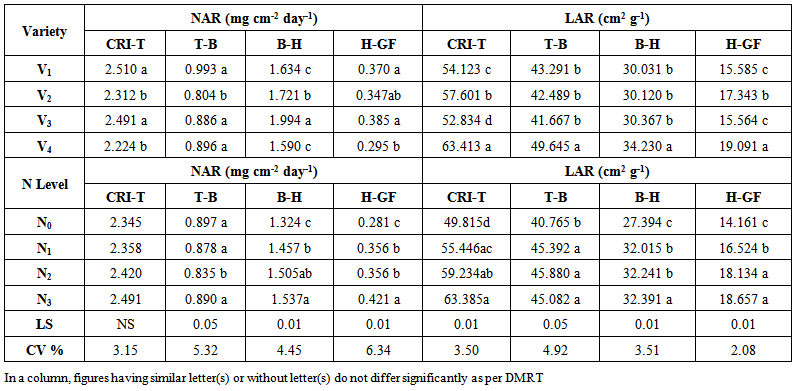 | Table 1. Effect of variety on NAR (mg cm-2 day-1) and LAR (cm2 g-1) at different growth stages of wheat |
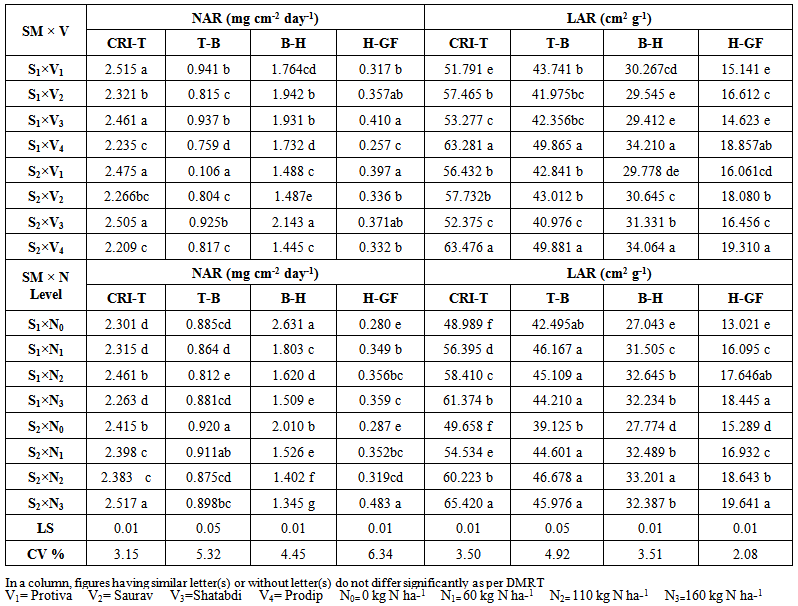 | Table 2. Interaction effect of sowing method and variety and sowing method and nitrogen level on NAR (mg cm-2 day-1) and LAR (cm2 g-1) at different growth stages of wheat |
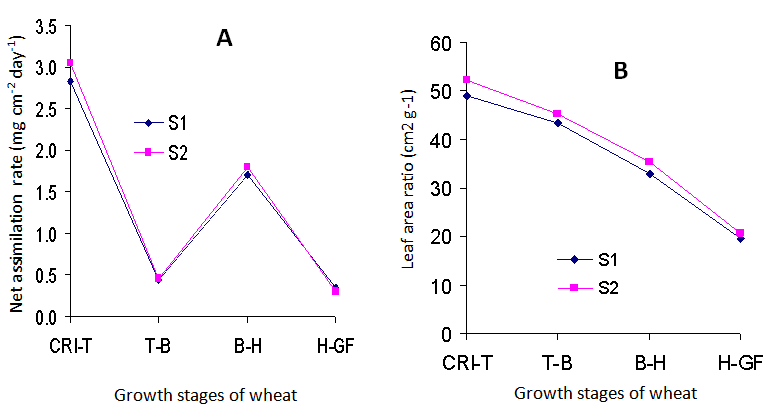 | Figure 1. Effect of sowing method on net assimilation rate (A) and leaf area ratio (B) at different growth stages of wheat |
 | Table 3. Effect of variety on SLA (cm2 g-1) and LWR (g g-1) at different growth stages of wheat |
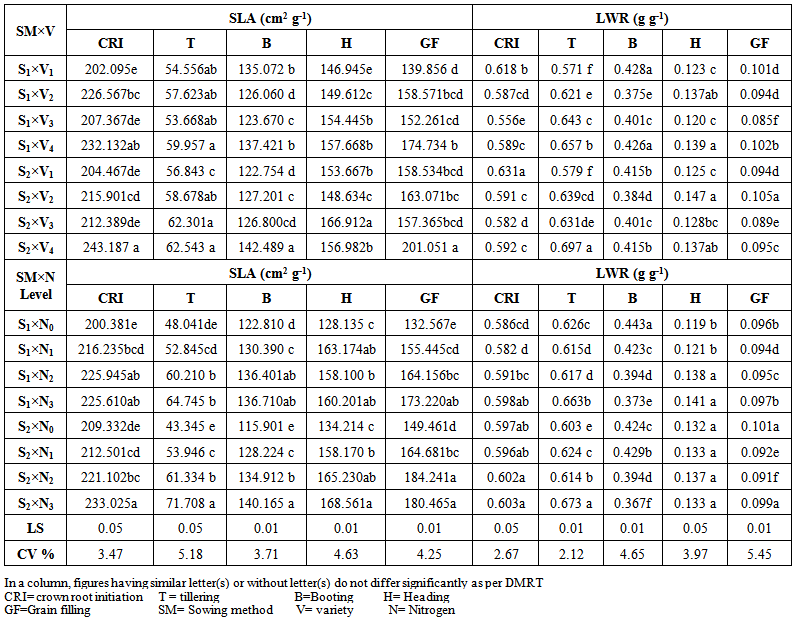 | Table 4. Interaction effect of sowing method and variety and sowing method and nitrogen level on SLA (cm2 g-1) and LWR (g g-1) at different growth stages of wheat |
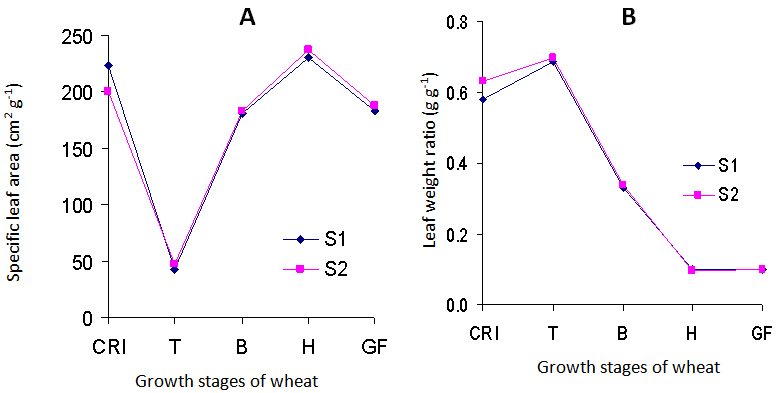 | Figure 2. Effect of sowing method on specific leaf area (A) and leaf weight ratio (B) at different growth stages of wheat |
4. Conclusions
- The over all result indicate that bed planting is better than conventional one. The values of physiological characters were highest at 160 N ha-1. Prodip performed better with 160 N ha-1 in bed planting system.
 Abstract
Abstract Reference
Reference Full-Text PDF
Full-Text PDF Full-text HTML
Full-text HTML